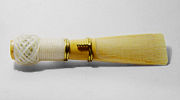- Double reed
-
A double reed is a type of reed used to produce sound in various wind instruments. The term double reed comes from the fact that there are two pieces of cane vibrating against each other. A single reed consists of one piece of cane which vibrates against a mouthpiece made of metal, hardened rubber, resin, or some other material. The term double reeds can also refer collectively to the class of instruments which use double reeds.
Contents
Construction
There are several differences, the most obvious being size, between various types of double reeds, for example between that for a bassoon and that for an oboe or a cor anglais (sometimes called an English horn).
Arundo donax cane is used for the making of double reeds. For bassoon reeds, tubes of this cane are first split lengthwise then gouged to a certain thickness. The chosen piece of cane is then cut to shape and the centre portion is thinned (profiled). The cane is folded end to end to form the two blades of the reed. The unprofiled end of the cane is shaped into a tube with the aid of a mandrel and bound with three strategically positioned wires. Additional binding using thread is added. The folded tip is cut off to allow the blades to vibrate and final adjustments to the interior of the reed using a reamer, and to the exterior using a reed-scraping knife, are carried out. The reed is then ready to fit to the bocal of the bassoon.
The construction of double reeds for the oboe family of instruments is similar in principle: like the bassoon's reeds, they consist of two pieces of Arundo donax cane fastened together with an opening at the tip. However, because the oboe does not have a bocal, the cane must be fastened to a metal tube (the staple), the lower half of which is normally surrounded by a piece of cork. The staple is then inserted into the farrow at the upper end of the oboe.
There are many different methods of making reeds and many variations of design have been developed. Players can buy reeds either ready-made, or in various stages of formation, such as part-scraped, reed blanks, or buy the staples and cane separately. Cane is sold in several forms: as tubes, gouged, gouged and shaped, or gouged and shaped and profiled. Bassoon cane has the further option of being profiled before purchase. Cane from several different regions is used in reed making, traditionally from southern France. There are also many options with regard to staples, shaping equipment and so forth which all have a subtle effect on the tone quality a reed will produce.
Playing a Double Reed
Bassoon double reeds are wider than oboe double reeds; they're also shorter and thus do not need such a tight embouchure in order to make a sound. Most double reed embouchures are the same. Players pull their lips over their teeth to protect the reed from their teeth.
List of instruments which use double reeds
Main Western orchestral instruments
Period instruments
Instruments where the reed is enclosed in a windcap
Instruments where the reed is not enclosed in a windcap
- baroque bassoon
- baroque oboe
- dulcian
- oboe da caccia
- rackett
- shawm
Other instruments
- bagpipes
- bombard
- duduk
- dulzaina
- guan
- gyaling
- hichiriki
- hojok
- kèn
- nadaswaram
- organ
- piffero
- pi nai (used in piphat)
- piri
- shehnai
- sralai
- sopila
- suona
- surnay
- tangmuri
- tarogato (early)
- tenora
- tible
Double reed societies
Double reed instruments (also includes those with quadruple and sextuple reeds; does not include bagpipes) European classical
(modern)European classical
(historical)Aulos · Baroque oboe · Bassanelli · Cornamuse · Cromorne · Crumhorn · Dulcian · Hirtenschalmei · Kortholt · Oboe da caccia · Pommer · Rackett · Rauschpfeife · ShawmAfrican traditional Asian traditional Balaban/Duduk/Mey · Guan · Gyaling · Hichiriki · Hne · Kèn · Kèn bầu · Kèn đám ma · Kuzhal · Mizmar · Nadaswaram · Pi · Piri · Shehnai · Sundari · Sorna · Sralai · Suona · Taepyeongso · Zurna/SurnaiEuropean traditional American traditional Categories:- Reedpipes
Wikimedia Foundation. 2010.


